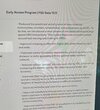Just doing an Apple transcribe of the pic:
Early Access Program | FSD Beta 10.11
- Upgraded modeling of lane geometry from dense rasters ("bag of
points") to an autoregressive decoder that directly predicts and
connects "vector space" lanes point by point using a transformer
neural network. This enables us to predict crossing lanes, allows
computationally cheaper and less error prone post-processing, and
paves the way for predicting many other signals and their
relationships jointly and end-to-end.
- Use more accurate predictions of where vehicles are turning or
merging to reduce unnecessary slowdowns for vehicles that will not
cross our path.
• Improved right-of-way understanding if the map is inaccurate or
the car cannot follow the navigation. In particular, modeling
intersection extents is now entirely based on network predictions
and no longer uses map-based heuristics.
- Improved the precision of VRU detections by 44.9%, dramatically
reducing spurious false positive pedestrians and bicycles
(especially around tar seams, skid marks, and rain drops). This was
accomplished by increasing the data size of the next-gen
autolabeler, training network parameters that were previously
frozen, and modifying the network loss functions. We find that this
decreases the incidence of VRU-related false slowdowns.
- Reduced the predicted velocity error of very close-by
motorcycles, scooters, wheelchairs, and pedestrians by 63.6%. To
do this, we introduced a new dataset of simulated adversarial high
speed VRU interactions. This update improves autopilot control
around fast-moving and cutting-in VRUs.
- Improved creeping profile with higher jerk when creeping sta
and ends.
Improved control for nearby obstacles by predicting continuc
distance to static geometry with the general static obstacle
network.
Reduced vehicle "parked" attribute error rate by 17%, achieve
increasing the dataset size by 14%. Also improved brake light
accuracy.
- Improved clear-to-go scenario velocity error by 5% and high
scenario velocity error by 10%, achieved by tuning loss functic
targeted at improving performance in difficult scenarios.
- Improved detection and control for open car doors.
- Improved smoothness through turns by using an optimizatio
based approach to decide which road lines are irrelevant for c
given lateral and longitudinal acceleration and jerk limits as wt
vehicle kinematics.
- Improved stability of the FSD UI visualizations by optimizing
ethernet data transfer pipeline by 15%.
Improved recall for vehicles directly behind ego, and improv
precision for vehicle detection network.
So 44.9%, 63,6%, 17%, 5%, 10% and 15%. Seems like crazy good numbers. But the first point is the most important. It’s pretty much an architecture change, I assume many other companies will not do that change for years if they decide to start that process today. Heck I think their engineers struggle to understand how that will even look like much less how to fit it into existing hardware that they have.




